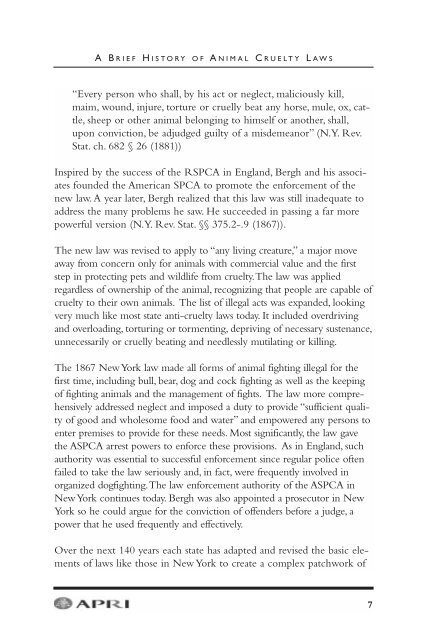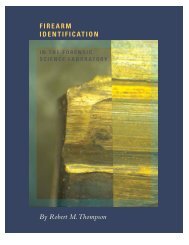Animal Cruelty Prosecution Animal Cruelty Prosecution
Animal Cruelty Prosecution Animal Cruelty Prosecution
Animal Cruelty Prosecution Animal Cruelty Prosecution
You also want an ePaper? Increase the reach of your titles
YUMPU automatically turns print PDFs into web optimized ePapers that Google loves.
A BRIEF H ISTORY OF A NIMAL C R UELTY L AWS<br />
“Every person who shall, by his act or neglect, maliciously kill,<br />
maim, wound, injure, torture or cruelly beat any horse, mule, ox, cattle,<br />
sheep or other animal belonging to himself or another, shall,<br />
upon conviction, be adjudged guilty of a misdemeanor” (N.Y. Rev.<br />
Stat. ch. 682 § 26 (1881))<br />
Inspired by the success of the RSPCA in England, Bergh and his associates<br />
founded the American SPCA to promote the enforcement of the<br />
new law. A year later, Bergh realized that this law was still inadequate to<br />
address the many problems he saw. He succeeded in passing a far more<br />
powerful version (N.Y. Rev. Stat. §§ 375.2-.9 (1867)).<br />
The new law was revised to apply to “any living creature,” a major move<br />
away from concern only for animals with commercial value and the first<br />
step in protecting pets and wildlife from cruelty.The law was applied<br />
regardless of ownership of the animal, recognizing that people are capable of<br />
cruelty to their own animals. The list of illegal acts was expanded, looking<br />
very much like most state anti-cruelty laws today. It included overdriving<br />
and overloading, torturing or tormenting, depriving of necessary sustenance,<br />
unnecessarily or cruelly beating and needlessly mutilating or killing.<br />
The 1867 New York law made all forms of animal fighting illegal for the<br />
first time, including bull, bear, dog and cock fighting as well as the keeping<br />
of fighting animals and the management of fights. The law more comprehensively<br />
addressed neglect and imposed a duty to provide “sufficient quality<br />
of good and wholesome food and water” and empowered any persons to<br />
enter premises to provide for these needs. Most significantly, the law gave<br />
the ASPCA arrest powers to enforce these provisions. As in England, such<br />
authority was essential to successful enforcement since regular police often<br />
failed to take the law seriously and, in fact, were frequently involved in<br />
organized dogfighting.The law enforcement authority of the ASPCA in<br />
New York continues today. Bergh was also appointed a prosecutor in New<br />
York so he could argue for the conviction of offenders before a judge, a<br />
power that he used frequently and effectively.<br />
Over the next 140 years each state has adapted and revised the basic elements<br />
of laws like those in New York to create a complex patchwork of<br />
7







